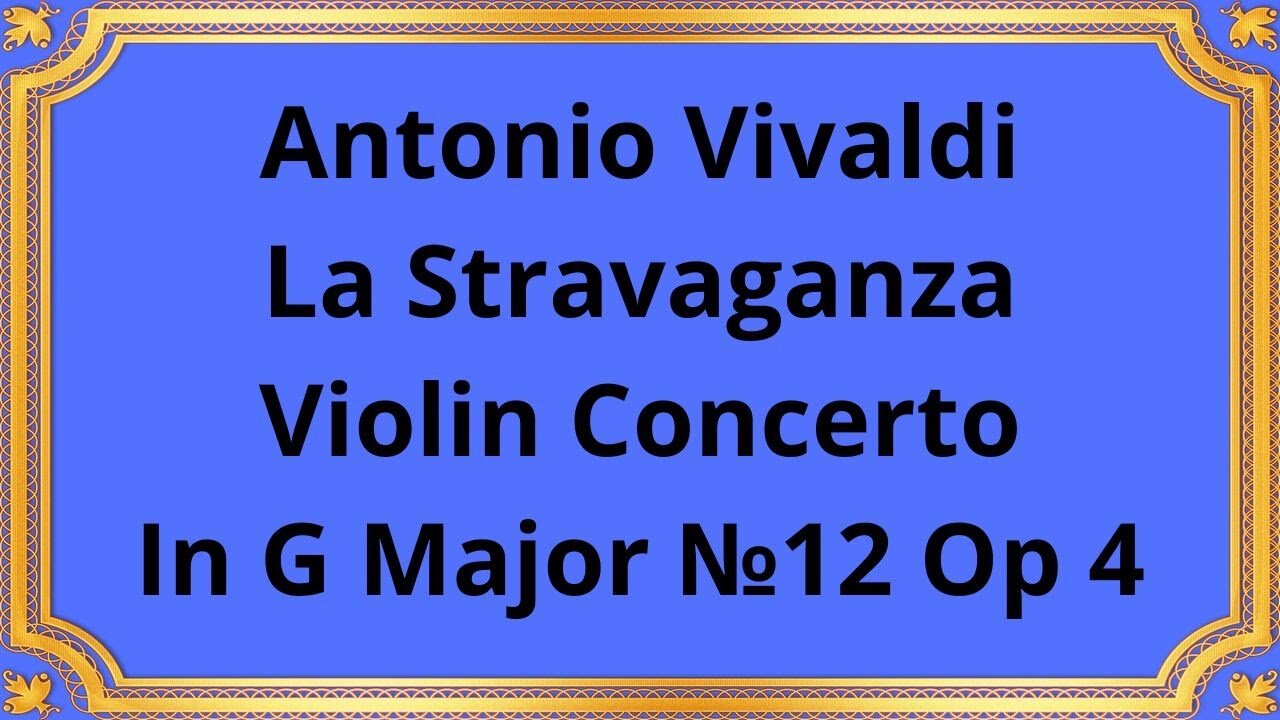Premium Only Content

Antonio Vivaldi The Stravaganza Violin Concerto In G Major №12 Op 4
#classicalmusic #Vivaldi #Stravaganza #ViolinConcerto #GMajor #Op4 #musiccomposition #baroquemusic #classicalcomposers #concertomusic #orchestralmusic
Antonio Vivaldi; Reinhold Barchet; Helma Elsner; Pro Musica Orchestra Stuttgart; Rolf Reinhardt
Antonio Vivaldi, one of the most influential composers of the Baroque era, left an indelible mark on the world of classical music. Among his vast repertoire, the Stravaganza Violin Concerto in G Major, No. 12, Op. 4 stands out as a masterpiece that showcases Vivaldi's exceptional talent and innovative approach to composition.
Antonio Vivaldi composed the Stravaganza Violin Concerto in G Major, No. 12, Op. 4 in the early 18th century. This period, known as the Baroque era, was characterized by elaborate ornamentation, rich harmonies, and virtuosic performances. Vivaldi's contribution to the development of the concerto form was immense, and this particular concerto exemplifies his mastery.
The Stravaganza Violin Concerto in G Major, No. 12, Op. 4 follows the typical three-movement structure of a concerto: fast-slow-fast. The first movement, marked Allegro, is a lively and energetic display of Vivaldi's compositional prowess. It features a virtuosic solo violin part, accompanied by a string orchestra. The second movement, marked Largo, provides a moment of introspection and tranquility, with the solo violin weaving a melodic tapestry accompanied by delicate harmonies. The final movement, marked Allegro, returns to the vibrant and spirited nature of the opening, with the solo violin leading the charge and engaging in playful dialogues with the orchestra.
What sets the Stravaganza Violin Concerto in G Major, No. 12, Op. 4 apart from other concertos of the time is Vivaldi's ingenious use of thematic material and his ability to create vivid musical imagery. The opening Allegro movement displays Vivaldi's trademark virtuosity, with rapid passages, intricate ornamentation, and brilliant melodic lines. The Largo movement, in contrast, showcases Vivaldi's lyrical sensibility, with long, expressive phrases and tender melodies. The final Allegro movement is characterized by rhythmic drive and energetic interplay between the soloist and the orchestra, creating a sense of exhilaration and joy.
The Stravaganza Violin Concerto in G Major, No. 12, Op. 4 stands as a testament to Vivaldi's innovation and mastery of the concerto genre. Its popularity has endured over the centuries, captivating audiences with its technical brilliance and emotional depth. Vivaldi's influence on future generations of composers cannot be overstated, as his innovative use of form, harmony, and virtuosic writing paved the way for the development of classical music as we know it today.
Conclusion:
Antonio Vivaldi's Stravaganza Violin Concerto in G Major, No. 12, Op. 4 is a remarkable musical composition that exemplifies the genius of this iconic Baroque composer. Its three-movement structure, virtuosic solo violin part, and expressive melodies continue to captivate audiences and inspire musicians around the world. By exploring the historical context, musical structure, and enduring legacy of this concerto, we gain a deeper appreciation for Vivaldi's contributions to the world of classical music and the timeless beauty of his compositions.
You have the opportunity to support the channel:
https://destream.net/live/RadSiarAl/donate
https://www.buymeacoffee.com/6355radsiaral
-
 1:03:25
1:03:25
Kyle Fortch
2 hours agoRick Barker: Managing & Developing Taylor Swift, Breaking Artists Today & MORE | THE ONE SHEET S1E5
2 -
 37:11
37:11
BonginoReport
4 hours agoDan Bongino is Leaving (Ep.146) - 02/24/2025
145K378 -
 LIVE
LIVE
Wendy Bell Radio
5 hours agoThe MAGA Diet
10,925 watching -
 1:22:03
1:22:03
Graham Allen
3 hours agoGRAHAM MAKES YUGE ANNOUNCEMENT!! + LIBERAL REP ROOTING AGAINST AMERICA?!
50.5K50 -
 1:01:28
1:01:28
Randi Hipper
1 hour agoETHEREUM PRICE BOUNCES AFTER BILLION DOLLAR HACK!
8.7K1 -
![Massive Paradigm Shift: Bongino Hired At FBI; Joy Reid Fired At MSBNC [EP 4450-8AM]](https://1a-1791.com/video/fwe1/52/s8/1/u/2/_/e/u2_ey.0kob-small-Massive-Paradigm-Shift-Bong.jpg) DVR
DVR
The Pete Santilli Show
16 hours agoMassive Paradigm Shift: Bongino Hired At FBI; Joy Reid Fired At MSBNC [EP 4450-8AM]
58.4K18 -
 1:27:17
1:27:17
Game On!
15 hours ago $2.71 earnedAnother Monday without football...
36.8K8 -
 1:43:56
1:43:56
Jeff Ahern
2 hours ago $2.60 earnedMonday Madness with Jeff Ahern (Ding Dong the Witch is Gone!)
29.4K3 -
 34:56
34:56
Athlete & Artist Show
23 hours ago $1.78 earnedCANADA WINS GOLD AGAIN!!
25.8K2 -
 15:27
15:27
T-SPLY
1 day agoCNN Forgets President Trump Can Fire Anyone He Wants From The Pentagon
36.9K25